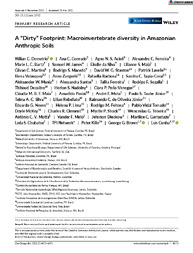A "dirty" footprint: macroinvertebrate diversity in Amazonian Anthropic Soils.
A "dirty" footprint: macroinvertebrate diversity in Amazonian Anthropic Soils.
Author(s): DEMETRIO, W. C.; CONRADO, A. C.; ACIOLI, A. N. S.; FERREIRA, A. C.; BARTZ, M. L. C.; JAMES, S. W.; SILVA, E. da; MAIA, L. S.; MARTINS, G. C.; MACEDO, R. S.; STANTON, D. W. G.; LAVELLE, P.; VELASQUEZ, E.; ZANGERLÉ, A.; BARBOSA, R.; TAPIA-CORAL, S. C.; MUNIZ, A. W.; SANTOS, A.; FERREIRA, T.; SEGALLA, R. F.; DECAËNS, T.; NADOLNY, H. S.; PEÑA-VENEGAS, C. P.; MAIA, C. M. B. F.; PASINI, A.; MOTA, A. F.; TAUBE JÚNIOR, P. S.; SILVA, T. A. C.; REBELLATO, L.; OLIVEIRA JUNIOR, R. C. de; NEVES, E. G.; LIMA, H. P.; FEITOSA, R. M.; TORRADO, P. V.; McKEY, D.; CLEMENT, C. R.; SHOCK, M. P.; TEIXEIRA, W. G.; MOTTA, A. C. V.; MELO, V. F.; DIECKOW, J.; GARRASTAZU, M. C.; CHUBATSU, L. S.; KILLE, P.; BROWN, G. G.; CUNHA, L.
Summary: Amazonian rainforests, once thought to be pristine wilderness, are increasingly known to have been widely inhabited, modified, and managed prior to European arrival, by human populations with diverse cultural backgrounds. Amazonian Dark Earths (ADEs) are fertile soils found throughout the Amazon Basin, created by pre-Columbian societies with sedentary habits. Much is known about the chemistry of these soils, yet their zoology has been neglected. Hence, we characterized soil fertility, macroinvertebrate communities, and their activity at nine archeological sites in three Amazonian regions in ADEs and adjacent reference soils under native forest (young and old) and agricultural systems.
Publication year: 2021
Types of publication: Journal article
Unit: Embrapa Western Amazon
Keywords: Amazonian Dark Earths, Ants, Archeological sites, Termites, Terra Preta de Índio
Observation
Some of Embrapa's publications are published as ePub files. To read them, use or download one of the following free software options to your computer or mobile device. Android: Google Play Books; IOS: iBooks; Windows and Linux: Calibre.
Access other publications
Access the Agricultural Research Database (BDPA) to consult Embrapa's full library collection and records.
Visit Embrapa Bookstore to purchase books and other publications sold by Embrapa.

